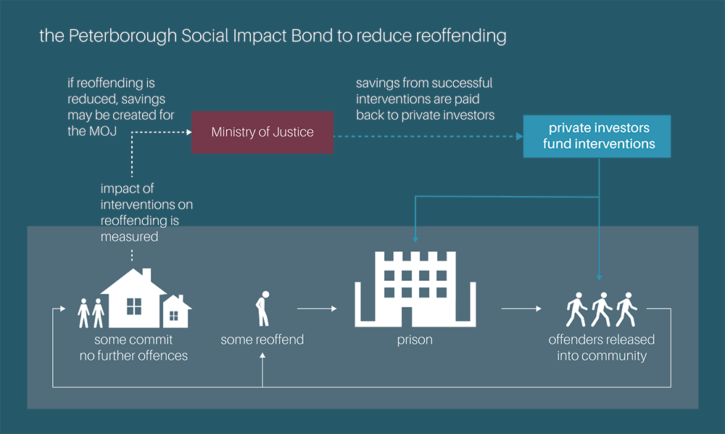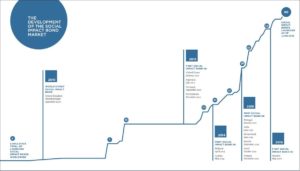The ONE Project
In the week before Christmas (17 December 2015) the MoJ published the final process evaluation of “The payment by results Social Impact Bond pilot at HMP Peterborough” undertaken by RAND Europe.
This pilot, known as the One Service, sought to reduce the reoffending of short term prisoners released from Peterborough prison by providing them with a range of co-ordinated advice and support services including, in particular, support from trained mentors. The pilot was operated by Social Finance funded via a Social Impact Bond (SIB) and operated by a partnership led by St Giles Trust. The target set for the Peterborough pilot was a reduction of 10% in the frequency of reconviction events in each cohort of around 1000 prisoners (calculated by comparison with a match group).
The pilot started in 2010 and was planned to run until 2017 but was discontinued early with the implementation of the government’s Transforming Rehabilitation project which split the probation service into two and made 21 new Community Rehabilitation Companies responsible for released prisoners, including those discharged from HMP Peterborough.
[divider]
The evaluation
This is the process evaluation report which looks at the workings of the scheme, rather than measuring its impact. The final outcome results are expected to be published in summer 2016. You can see my summary of the latest set of results here. The evaluation was designed to address five key questions:
- How, if at all, did the pilot lead to better outcomes of reduced reoffending (including the role played by voluntary and community sector organisations and partner agencies)?
- What wider costs and benefits, if any, do stakeholders feel were incurred through the implementation of the SIB?
- To what extent did stakeholders feel that the SIB led to greater innovation and/or efficiency?
- What were the strengths and weaknesses of the SIB contractual model as implemented?
- What key messages can be taken from the Peterborough pilot that offer useful learning points for future payment by results models and SIBs?

Interestingly, although released prisoners were eligible for support from the One Service for one year, most chose to end their contact after a few months. Commonly, there was intense period of contact following release, after which contact tapered off. Just one in five service users were still in contact after three months.
Reduced reoffending?
Virtually all service users interviewed for the research (all of whom had voluntarily engaged with the One Service) were very positive about their experience, expressing satisfaction with the services they received and their relationship with One Service staff and volunteers. They felt that the ability of the One Service to respond to acute practical needs in situations that might otherwise lead to reoffending was particularly valuable. Interviewed service users were somewhat equivocal on the degree to which the One Service had an impact on reoffending more broadly, but emphasised that the One Service was an improvement on their prior experience of post-release support.
Stakeholders identified five key strengths:
- Delivering an individualised service, responsive to the identified needs of each service user.
- Addressing practical problems such as housing, benefits, training and education.
- Investing time in the development of processes and procedures to operate within the prison and in the community as a through-the-gate service − for example, to improve and facilitate information sharing or practitioners’ access to the prison.
- Actively supporting service users to engage with local services and establishing good partnership working with local employment, housing and substance misuse treatment agencies.
- Changing and adapting the approach to working with service users during the course of the pilot in order to better meet service users’ needs.
[divider]
Wider costs and benefits
None of the stakeholders reported any major costs or disadvantages, the wider benefits consisted mainly from building on the networks developed in the course of the pilot. The most tangible benefit was that Peterborough prison developed an ‘Outside Links’ centre to provide support for all prisoners on the day of release.
[divider]
Innovation and efficiency
The pilot was widely claimed to have been set up to stimulate innovation, although it was based on a previous model already developed by St Giles trust. Nevertheless, the SIB funding was found to be flexible and allowed staff to use a personalised budget approach to resolve issues for individual service users as well as incentivising engagement.
The online case management database was accessible to workers from a range of agencies which was found to be very helpful in co-ordinating interventions.
[divider]
Strengths and weaknesses of the SIB contract
The main strength of the SIB model, which was underpinned by philanthropic investors, was that voluntary sector providers were insulated from financial risk and could focus on service development.
[divider]
Key messages
The evaluation identified a number of key learning points:
- Having a dedicated service director, focused on coordinating and facilitating partnership working was central to the implementation and operation of the project.
- Key stakeholders had established information sharing processes before the start of the pilot which greatly facilitated partnership working.
- Service users were able to access individualised support which was mainly practical in nature.
- Most service users disengaged from the One Service well before the expiry of their 12 months available support
- While volunteers provided additional valued support to service users, recruitment of volunteers was sometimes challenging.
It will be interesting to see how many of these learning points are taken on by the new Community Rehabilitation Companies as they seek to reduce the reoffending of short-term prisoners across England and Wales.







8 Responses
So – did it help reduce reoffending or not???
No it was a massive con to push through privatisation of probation.
Hi Anita,
That’s the $64,000 question that we have to wait until the summer to find out. The answer at the moment is probably, yes it did, but not as much as was hoped. See: http://test18.russellwebster.com/peterborough-prison-pbr-pilot-results-improving-but-still-below-target/ for more detail
As a practitioner who was the SPOC for the One Service in Probation, I concur with the positive process outcomes but as pointed out the service users were all motivate in the first place. CRCs will have to try and support service users who don’t want the practical help (perceived as interference) and with less resources. The One Service were able to pay for B&B on release for someone who was NFA for example. As Mr Grayling said give them accommodation and a job and they will be fine unfortunately in Peterborough there are very few jobs and no accommodation that could be deemed as suitable. Nick S.
Thanks very much for your comment, Nick. It’s invaluable to have some first-hand input. As you say, accommodation and employment are critical, and the first in particular is very hard to arrange.
Best Wishes
Russell
My guess would be unlikely.
Hi Russell
I am the Justice Liaison Manager for the Veterans Change Partnership. Having graduated with a degree in Psychology (Specialised in Criminology) I have spent my entire career supporting individuals towards inclusion. My particular specialism is supporting offenders with their resettlement.
I was interested to read your article and agree completely that three of the key elements towards successful resettlement are:-
1) Co-ordination
2) Partnership
3) The ability to address need
Regrettably, all too often these three critical elements do not receive the priority that they require.
The Veterans Change Partnership is a C.I.C Company that will be supporting Veteran offenders. Support will either be at the point of discharge from the Secure Estate or as a condition of a Community sentence.
A key element of the support provided will be high quality co-ordination of intervention from referral to successful resettlement. (Including close liaison with CARAT, Resettlement, Education and Healthcare Departments) We will deliver this via quality partnerships across all three sectors. (Pubic, Private and Not for Profit) A comprehensive case management model, facilitating quality assessments, planning and review of need will enhance the process.
I wonder whether you are aware of similar types of support available for Veteran offenders?
Hi Mark
Thanks very much indeed for your comment. I’d be interested in resettlement focused on veteran offenders but am only aware of the Phillips report and the government response.
Best Wishes
Russell